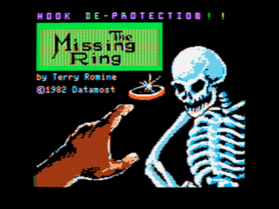The Missing Ring
The Missing Ring is a computer role-playing game written by Terry Romine for the Apple II and published in 1982 by Datamost.[1]
| The Missing Ring | |
|---|---|
 | |
| Publisher(s) | Datamost |
| Designer(s) | Terry Romine[1] |
| Platform(s) | Apple II |
| Release | 1982 |
| Genre(s) | RPG |
| Mode(s) | 1-5 players |
The Missing Ring is a fantasy adventure with a similar premise to the Dungeons & Dragons role-playing game series: a band of adventurers, which may include humans, elves, dwarves or wizards, enters an enchanted palace to seek treasure and slay enemies. The ultimate objective is to find a wizard's ancient ring.
Gameplay
Before play begins, the player selects an adventuring party to send into the map. The party may include up to five characters drawn from the following nine classes:
- Fighter with Sword
- Wizard
- Elf with Bow
- Dwarf with Ax
- Fighter with Ax
- Elf with Sword
- Dwarf with Hammer
- Fighter with Bow
- Cleric
The player may also visit the merchant and spend gold to equip the characters with such things as healing potions. Once the party is assembled, the player selects one of ten different maps to explore and play begins. Though one player can control all the characters, the game can also be played with multiple players, each controlling a single character in the party.
Characters appear as small, white silhouettes, and move through rooms rendered as perspective line drawings. A header at the top of the screen indicates the room being shown, and a footer gives details about the active character, including his level, health and experience.
Two complete sets of controls are arranged at either end of the keyboard, allowing two people to play simultaneously without having to trade off. The key assignments are:

| Action | Left | Right |
| Move forward | R | O |
| Move back | D | L |
| Move right | F | P |
| Move left | E | K |
| Attack | Space bar | |
| Healing potion | H | |
| Search for secret doors | S | ; |
| Get treasure | T | U |
| Magic item/spell | V | M |
| Pass/end player's turn | Y | |
| Pause | Esc | |
| Quit/save game | Q | |
| Open door with key | X | . |
Reception
In 1984 Softline readers named the game the eighth-worst Apple program of 1983.[2]
References
- Hague, James. "The Giant List of Classic Game Programmers".
- "The Best and the Rest". St.Game. Mar–Apr 1984. p. 49. Retrieved 28 July 2014.